This easy cajun-baked salmon recipe is ready in just 10-minutes! Get all of my best tips for cooking salmon in the oven that turns out perfectly every time!
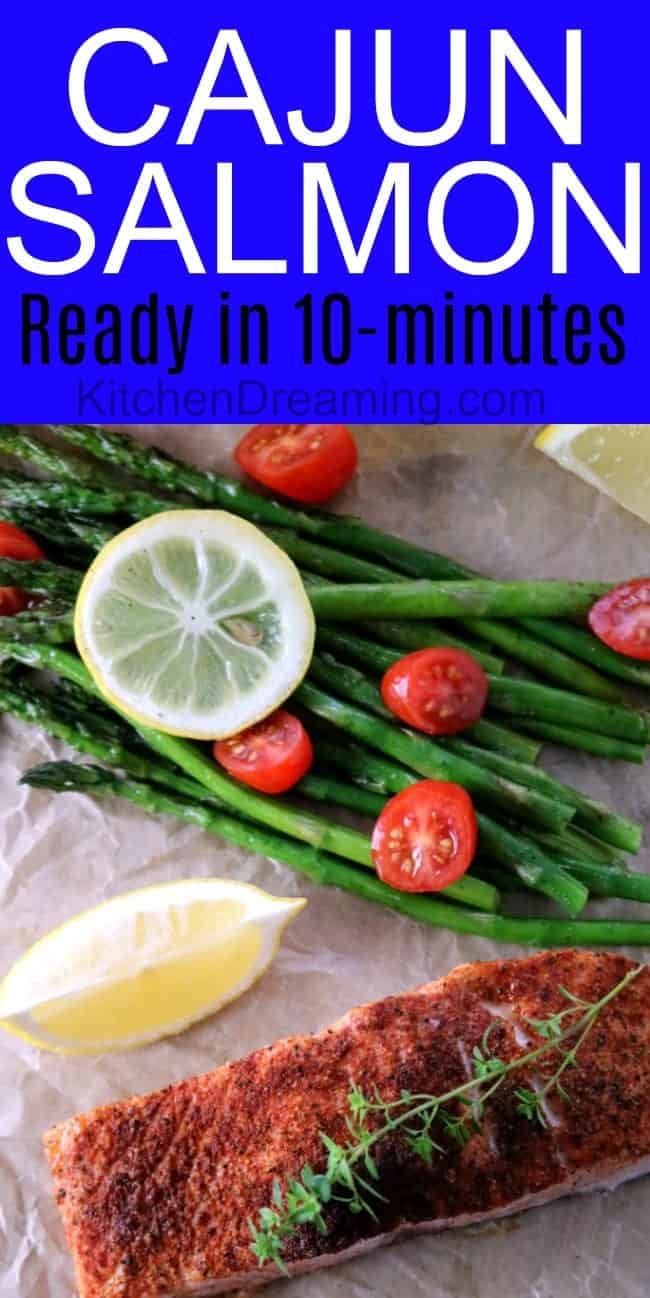
One of the types of fish that readers write and request more information and recipes about is salmon. Salmon is readily available in most grocery stores and is packed with protein and omega-3s. It pairs well with a variety of seasonings and sauces, too.
Salmon has a very light taste with a meaty texture that stands up well to many different cooking styles. This recipe is for a cajun-style oven-baked salmon with an easy lemon-butter sauce.
Quick cooking and delicious, this is a meal you can deliver to the table in under 15 minutes.
Ingredients for Cajun Salmon:
To make this baked salmon recipe, you will need:
- Salmon: When it comes to purchasing salmon, I recommend looking for fillets that have bright, silvery skin and shiny dark pink to red colored flesh. Fresh fish should not smell “fishy”; it should have a very low odor or smell briny like the ocean.
- If only frozen salmon is available in your area, choose a brand you trust. Follow thawing instructions located in the FAQ section of this post.
- Oil: I prefer to use extra-virgin olive oil for this recipe since we will be able to taste the oil, you want to use a quality cooking oil for this recipe.
- Cajun Seasoning: Store-bought or freshly prepared both work fine with this recipe. I have included a homemade blend on the recipe card.
- Butter: I use unsalted sweet cream butter. If you use salted, decrease the salt by 1/4 tsp in the Cajun seasoning.
- Lemon Juice and Zest: Freshly squeezed lemon juice is best for this recipe. I have not found any bottled lemon juice that tastes as bright and natural as a fresh lemon.
- Freshly Chopped Parsley: I prefer Italian flat-leaf parsley, but curly will also work. This lemon butter is also good with fresh chives.
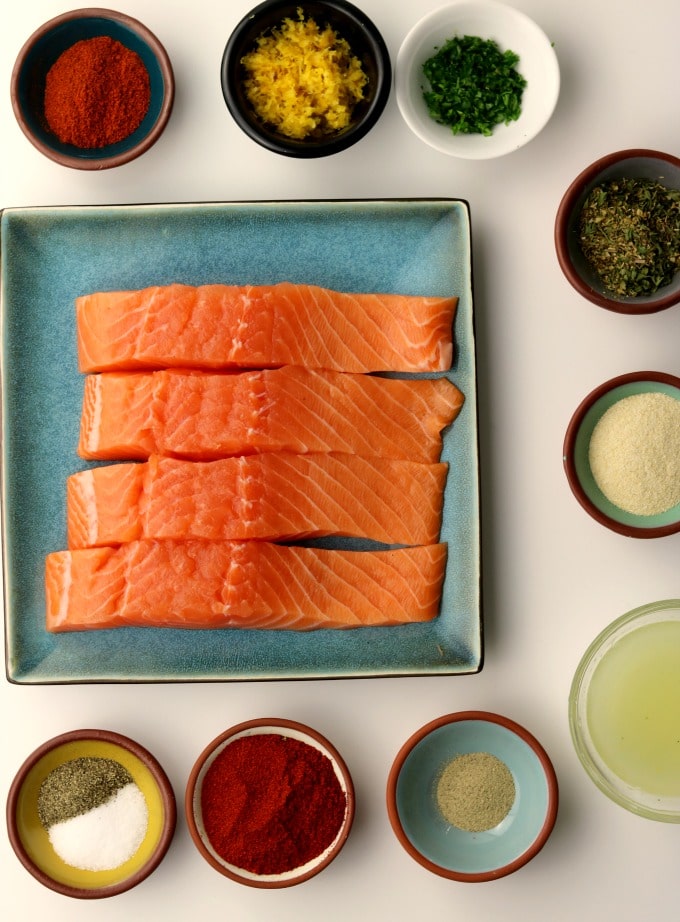
How to make Cajun Salmon
So, you’ve got the salmon portioned out and seasoned. Now, let’s talk now about baking the salmon in the oven.
- Bring the salmon to room temperature. Just like other meats, bring your salmon fillets out of the fridge and let them rest out on the counter for 15-30 minutes to come to room temperature. This promotes even cooking. Cooking it still cold from the refrigerator will result in overly done small ends as compared to the middle thickness.
- Check for Bones: Salmon fillets usually come cleaned and ready to go from the market, but it’s always a good idea to run your fingers over the flesh and check for any small bones. These can be removed usually by hand but also with a pair of kitchen tweezers.
- Season the salmon. Place the salmon fillets skin side down on aluminum foil or parchment-covered baking sheet. Brush the top and sides with a little olive oil. Sprinkle the tops with the cajun seasoning and gently massage it in for an even coating.
- For children’s portions, consider seasoning with salt and pepper only as cajun seasoning can be a spicy for the little ones’ palates.
- Bake. Bake at 450°F until the internal temperature of the salmon reaches 145°F. How long to bake salmon will depend on the thickness of the fillets. For fillets cut into 4-ounce portions, figure on about 8-10 minutes. You can test for doneness by a thermometer or by inserting a fork into the salmon and giving it a half twist; the fish should flake apart easily and glisten in the center.
- Prepare the Sauce. While the salmon bakes, prepare the lemon-butter sauce by melting the butter and combining with the lemon zest and lemon juice along with freshly chopped parsley (chives also work well here).
- Transfer salmon to a serving plate. Remove salmon from the oven and allow to rest for 5 minutes before transferring to serving plates. Top each filet with a tablespoon of lemon-butter sauce.
- Serve immediately.
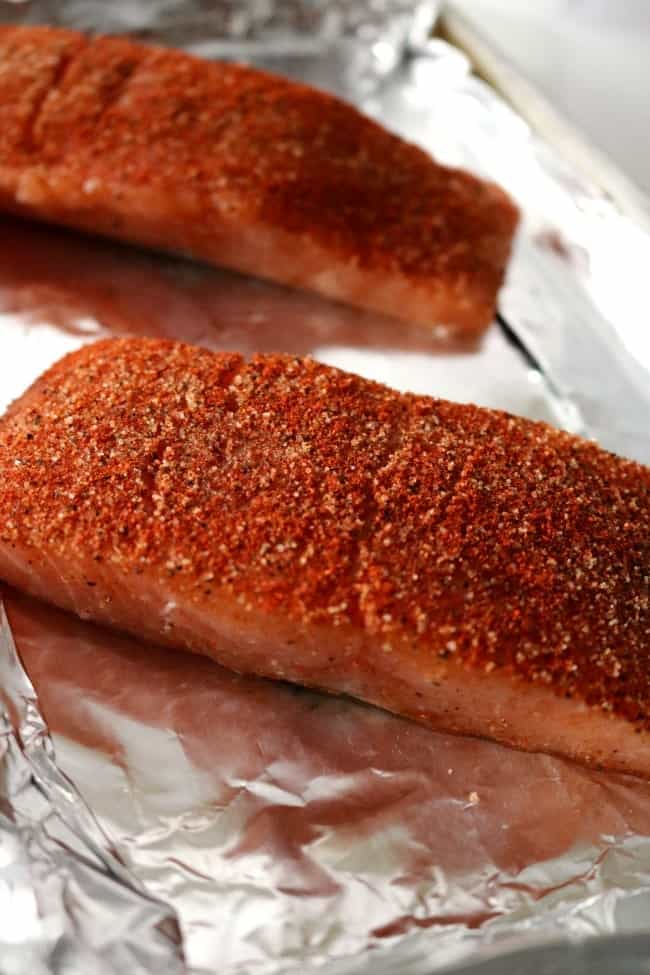
What Sauce Goes With Cajun Salmon
Fresh herbs add a lot of flavor that enhances the fish without overpowering it. For this recipe, I prefer a lemon butter sauce with fresh parsley or chives.
The lemon balances out the heat from the spicy cajun seasoning making this a very well-rounded dish. To take this sauce to the next level, add a tablespoon of capers. Capers are salty and a little briny, they go great with butter sauce and fish.
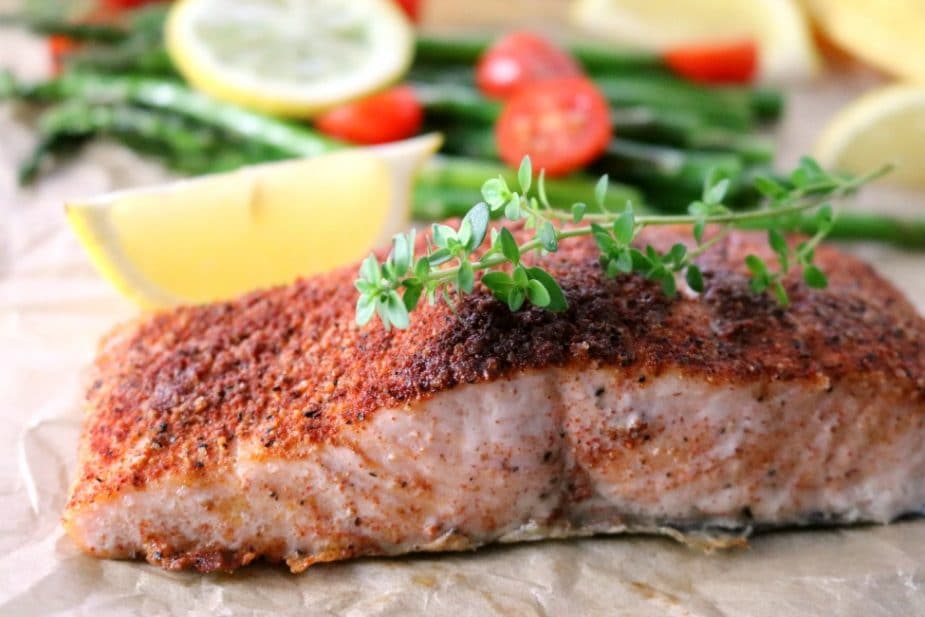
What to Serve with Salmon:
For this dish, I prefer sides that complement and pair well with the lemon sauce like roasted asparagus and couscous. Rice pilaf, any variety of steamed vegetables, or even a freshly tossed salad also go very well with salmon.
- Garden Vegetable Rice
- Apple Pecan Blue Cheese Salad with Apple Vinaigrette Dressing
- Quick and Easy Asparagus Salad
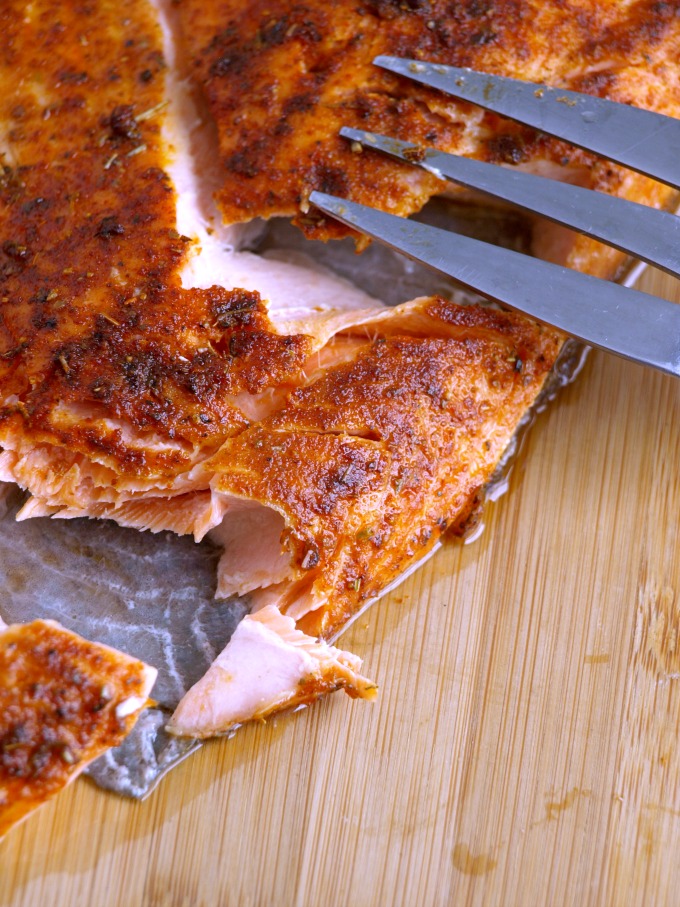
Recipe Variations
- Cajun Grilled Salmon:
- Season salmon fillets with a Cajun spice blend, including paprika, cayenne pepper, garlic powder, onion powder, thyme, and oregano.
- Drizzle olive oil over the salmon and let it marinate for about 30 minutes.
- Grill the salmon over medium-high heat until it’s cooked through, typically around 4-5 minutes per side.
- Serve with your favorite side dishes, such as rice, vegetables, or a fresh salad.
- Blackened Cajun Salmon:
- Coat salmon fillets with a Cajun spice mix, pressing the spices onto the fish.
- Heat a cast-iron skillet [paid link] over high heat and add a bit of oil.
- Place the salmon fillets in the skillet and cook for 2-3 minutes per side until the spices create a blackened crust.
- Serve with a squeeze of lemon and a side of coleslaw or mashed potatoes.
- Baked Cajun Salmon with Lemon Butter Sauce:
- Preheat the oven to 375°F (190°C).
- Season salmon fillets with Cajun spices and place them in a baking dish.
- In a small saucepan [paid link], melt butter and mix in lemon juice, minced garlic, and chopped parsley.
- Pour the lemon butter sauce over the salmon.
- Bake for about 15-20 minutes or until the salmon flakes easily with a fork.
- Garnish with additional fresh herbs and serve with rice or roasted vegetables.
Serving Suggestions
- Cajun Salmon with Roasted Vegetables: Serve Cajun salmon alongside a medley of roasted vegetables such as bell peppers, zucchini, and cherry tomatoes. The combination of the spicy salmon and the sweetness of roasted vegetables creates a well-balanced and flavorful meal.
- Cajun Salmon Tacos: Flake the Cajun salmon into smaller pieces and use it as a filling for soft tacos. Top with shredded cabbage, diced tomatoes, avocado slices, and a dollop of sour cream. This creates a delicious and handheld version of Cajun salmon.
- Cajun Salmon Salad: Place Cajun salmon fillets on a bed of fresh mixed greens or spinach. Add cherry tomatoes, cucumber slices, red onion, and a drizzle of vinaigrette dressing for a light and refreshing Cajun salmon salad.
- Cajun Salmon Bowls: Create grain bowls with Cajun salmon as the protein. Serve it over cooked quinoa or rice, and add sautéed or roasted vegetables. Drizzle with a yogurt-based Cajun sauce or tzatziki for extra creaminess.
- Cajun Salmon Pasta: Incorporate Cajun salmon into a pasta dish by flaking the salmon and mixing it with cooked pasta. Add a creamy Cajun Alfredo sauce, diced bell peppers, and grated Parmesan cheese for a comforting and indulgent pasta meal.
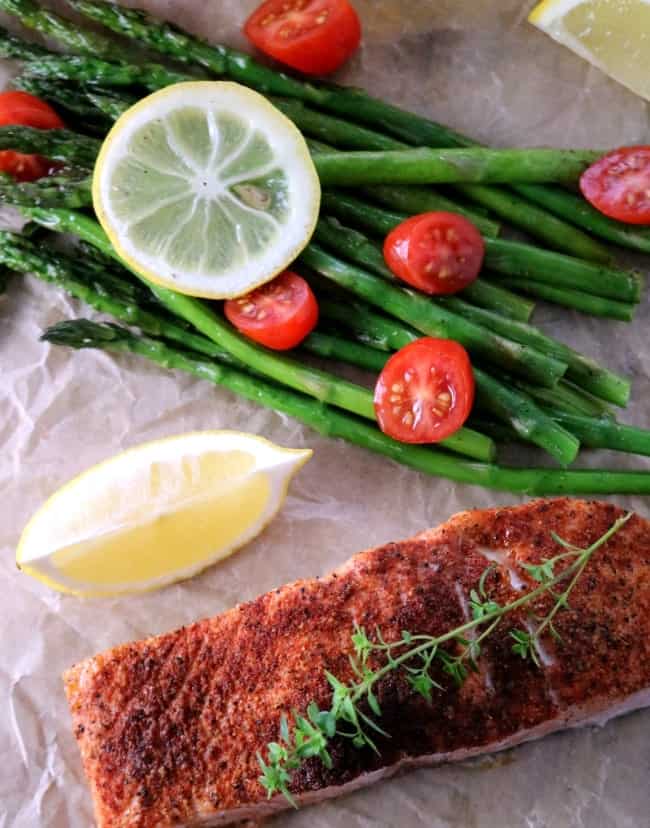
Storing, freezing, and reheating instructions
Storing:
- Refrigeration: If you have leftover Cajun salmon, store it in an airtight container in the refrigerator for up to 2-3 days. Make sure to allow it to cool to room temperature before refrigerating.
Freezing:
- Individual Fillets: If you want to freeze individual fillets, wrap each fillet tightly in plastic wrap and then place them in a freezer-safe bag. Label with the date. Frozen Cajun salmon can be stored for up to 2-3 months.
- Complete Meals: If you’ve prepared a full Cajun salmon dish with sides, you can freeze it in airtight containers. Ensure the dish is cooled before freezing. Label with the date and consume within 2-3 months for optimal quality.
Reheating:
- Oven or Toaster Oven:
- Preheat the oven to 350°F (175°C).
- Place the Cajun salmon on a baking sheet.
- Cover with foil to prevent drying out.
- Reheat for about 10-15 minutes or until warmed through.
- Microwave:
- Place individual portions of Cajun salmon on a microwave-safe plate.
- Cover with a damp paper towel to retain moisture.
- Heat in 30-second intervals, checking and stirring until the desired temperature is reached.
- Stovetop:
- For pan-seared Cajun salmon, you can reheat in a skillet over medium heat.
- Add a bit of oil or butter to prevent sticking.
- Heat each side for a few minutes until warmed through.
- Thawing Frozen Salmon:
- If you’ve frozen Cajun salmon, thaw it overnight in the refrigerator before reheating. This ensures a more even and safe thawing process.
Frequently Asked Questions (FAQs)
Can I Eat The Salmon Skin?
Yes, as long as it’s been cleaned and scaled. Salmon skin is best eaten after it’s been grilled, broiled, or seared. The skin is not ideal when it’s been cooked skin side down (like in this recipe) in the oven and tends to be rubbery. Therefore, I usually cook salmon with the skin on and remove it just before serving. To serve salmon without the skin, simply run your spatula u003cemu003ejustu003c/emu003e under the flesh and above the skin and the salmon will lift right off.
What Is A Serving Size For Salmon?
The recommended serving size for salmon as an entree is 4 ounces. So for a dinner party, I generally calculate 4 ounces per guest for average eaters and 6 ounces for big eaters. For an appetizer-sized portion, I use 2 – 3 ounce servings.u003cbru003eAs a rough guide, a 3-ounce portion (for my hand size) is about 2 fingers wide, 4-ounce portions are about 3 fingers wide, and 6-ounce portions are about 4 fingers wide. I use this formula in combination with my digital kitchen scale and over time found a measuring system that works well for me to be able to cut appropriate portions.
Can I Cook My Salmon More / Less Than The Recipe States?
Some people prefer their salmon to be more or less well-done than prescribed in this recipe. The USDA recommends cooking salmon to an internal temperature of 145 degrees F, so that’s why I stated this temperature.u003cbru003eUsing a meat thermometer, I remove the salmon at 140 degrees F and allow it to rest for 5 minutes before serving. During this resting period, the fish continues to cook raising the internal temperature of the fish to the recommended 145 degrees F.
What’s The Best Way To Thaw Frozen Salmon?
To thaw salmon, wrap it in plastic and allow it to thaw naturally in the refrigerator overnight. Rinse and blot dry with paper towels before seasoning.
How Do I Store Leftover Salmon?
Store the remaining cooked salmon in the refrigerator in a tightly covered container not made from metal. Use leftovers within 3 days.
How Do I Reheat Leftover Salmon?
Place the fillets on a rimmed baking sheet, cover them with foil (to prevent drying out the fillets), and heat in a 275-degree F oven until the fish registers 125 to 130 degrees F. This will take about 15 minutes for a 1-inch-thick fillet. Reheating times will vary according to the size and thickness of the fillets.
What Else Can I Prepare With Leftover Salmon?
As an alternative to reheating, I recommend serving leftover salmon in a cold application like a salad with Caesar dressing or Salmon Rillettes Spread.
Wine and Cocktail Pairings
Wine Pairings:
- Chardonnay:
- The buttery and oakiness of a Chardonnay complements the richness of Cajun salmon. Look for a medium to full-bodied Chardonnay with balanced acidity to enhance the flavors.
- Pinot Noir:
- A light to medium-bodied Pinot Noir with its red fruit flavors, subtle earthiness, and soft tannins can be a great match for Cajun salmon. It doesn’t overpower the dish and adds a nice contrast.
- Sauvignon Blanc:
- For a refreshing and crisp option, consider a Sauvignon Blanc. Its citrusy and herbal notes can provide a bright contrast to the spiciness of Cajun seasoning, creating a well-balanced pairing.
Cocktail Pairings:
- Cajun Bloody Mary:
- Add a Cajun twist to a classic Bloody Mary by incorporating Cajun spices into the mix. Garnish with a celery stick, olives, and a lemon wedge. The savory and spicy flavors complement the Cajun salmon.
- Spicy Margarita:
- A Spicy Margarita with a kick of heat from jalapeños pairs well with Cajun salmon. The citrusy and spicy elements in the cocktail can enhance the overall dining experience.
- Mango Habanero Mojito:
- Create a tropical and spicy cocktail by making a Mango Habanero Mojito. The sweetness from mango, the heat from habanero, and the freshness from mint can harmonize with the Cajun flavors.

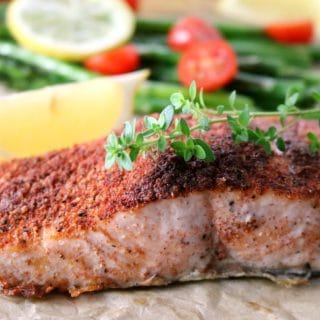
Baked Cajun Salmon with Lemon Butter Sauce
Equipment
- Digital meat thermometer
- fish spatula [paid link]
- parchment paper [paid link] or aluminum foil
Ingredients
- 16 oz Salmon , bones removed (4- 4oz fillets)
Cajun Seasoning:
- 1 tablespoon ground paprika
- 1/2 tablespoon ground cayenne pepper
- 1/2 tablespoon onion powder
- 1 teaspoon salt
- 1/4 teaspoon ground white pepper
- 1/4 teaspoon ground black pepper
- 1/2 teaspoon dried thyme
- 1/2 teaspoon dried oregano
- 1/2 teaspoon dried basil
Lemon-Butter Sauce:
- 4 tablespoons butter
- 2 teaspoons grated lemon rind
- 4 teaspoons fresh lemon juice
- 2 teaspoons chopped fresh parsley
- 1 tablespoon capers optional
Instructions
- Preheat oven. Preheat the oven to 450 degrees F.
- Mix the Cajun seasoning: In a small bowl, mix all the Cajun Seasoning ingredients.
- Prepare the Salmon: Line a baking sheet parchment paper [paid link] or aluminum foil for easy clean-up. Salmon fillets usually come cleaned and ready to go from the market, but it’s always a good idea to run your fingers over the flesh and check for any small bones. These can be
removed usually by hand but also with a pair of kitchen tweezers.
Sprinkle each fillet evenly over the top with the seasoning mixture. Gently rub the mix around to get even coverage. Bake for 8-10 minutes or until fish flakes easily. The salmon is done when it reaches an internal temperature of 145 degrees F. Do this by placing the tip of the meat thermometer gently into salmon fillet at its thickest part. - Prepare the Lemon Butter Sauce: While the fish bakes, prepare the lemon butter sauce by melting the butter either in a small saucepan [paid link] or in the microwave. Add the lemon zest and juice and stir to combine. Stir in the fresh parsley. Spoon sauce over fish at the table or just before serving.

This Cajun fish looks great! I can’t wait to try it out. Hope you are doing well!
Heidy
Hi Heidy,
So great to hear from you. I am doing very well, thank you for asking. I hope you are doing well amid the craziness in the world right now. Thanks for taking the time to stop in and say hi.
Yummy. Thanks for the recipe
This was the BEST salmon recipe I have found so far. I baked the asparagus on the same baking sheet and sautéed fresh spinach with a bit of olive oil, salt & pepper on the stovetop, and put lemon sauce over everything. I literally chewed with my eyes closed, it was that good!
Hi Deborah!
OMGosh that is the sweetest compliment. I am SO glad you enjoyed this recipe. :) Thank you for coming back by and sharing your experience.
Thanks for the wonderful post
Thanks Essie – so glad you enjoyed it.
Made this with some rainbow trout instead of salmon and it was amazing. So tender with a kick from the seasonings.
Thanks Marquita! I’m so happy you enjoyed it!
Wonderful and delicious! Quick and easy. Perfect for our busy household. Thanks for sharing.
Perfect recipe for Father’s Day dinner. Fresh salmon was great
Picked up some beautiful salmon last night after seeing this beautiful photos on Pinterest. I was not disappointed. The Cajun is great alone but the lemon butter really balanced the spice. Thank you for a new way to prepare salmon.
The lemon butter sauce was perfect with this cajun seasoning. THanks!
Thanks, Kacey! I’m so glad that you liked it.
This was perfect. We loved that it was spicy without being too oper-powering to the salmon. This would be great on my next batch of rainbow trout since they are so similar in texture and flavor.
Very tasty and different take on salmon. Thanks for sharing.